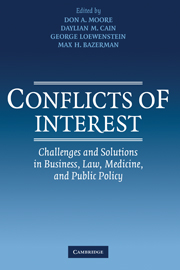Book contents
- Frontmatter
- Contents
- List of Contributors
- Acknowledgments
- Introduction
- PART ONE BUSINESS
- PART TWO MEDICINE
- 9 Physicians' Financial Ties with the Pharmaceutical Industry: A Critical Element of a Formidable Marketing Network
- 10 Commentary: How Did We Get into this Mess?
- 11 Why Are (Some) Conflicts of Interest in Medicine So Uniquely Vexing?
- 12 Commentary: Financial Conflicts of Interest and the Identity of Academic Medicine
- PART THREE LAW
- PART FOUR PUBLIC POLICY
- Index
- References
9 - Physicians' Financial Ties with the Pharmaceutical Industry: A Critical Element of a Formidable Marketing Network
Published online by Cambridge University Press: 04 August 2010
- Frontmatter
- Contents
- List of Contributors
- Acknowledgments
- Introduction
- PART ONE BUSINESS
- PART TWO MEDICINE
- 9 Physicians' Financial Ties with the Pharmaceutical Industry: A Critical Element of a Formidable Marketing Network
- 10 Commentary: How Did We Get into this Mess?
- 11 Why Are (Some) Conflicts of Interest in Medicine So Uniquely Vexing?
- 12 Commentary: Financial Conflicts of Interest and the Identity of Academic Medicine
- PART THREE LAW
- PART FOUR PUBLIC POLICY
- Index
- References
Summary
In the course of an extensive examination of physicians' financial conflicts of interest with the pharmaceutical industry, I gradually became aware that my perspective on this involvement had been naively narrow. Although I knew that the industry had done more than just engage practicing doctors and academic physicians in its marketing efforts, I had only a vague concept of the extent of the involvement or of the complex interactions between the companies, the doctors, and many others. My view of these vast connections and their interactions developed after reading two books on the evolving science of networks (Barbasi, 2003; Watts, 2003). The concept that evolved posits that the pharmaceutical industry, either deliberately or perhaps inadvertently, has combined willing physicians, physicians' professional organizations, physician-run disease registries, nurses, celebrities, health charities, and the lay public into an enormous interlacing network that functions as a highly effective marketing tool for prescription drugs. This marketing network is sufficiently successful to help the pharmaceutical industry outperform all other industries in profitability. It appears that the network of physicians has reached critical mass; most of us have had no idea that it even exists. In short, the whole has apparently become far more powerful than the sum of its parts.
- Type
- Chapter
- Information
- Conflicts of InterestChallenges and Solutions in Business, Law, Medicine, and Public Policy, pp. 133 - 141Publisher: Cambridge University PressPrint publication year: 2005
References
- 1
- Cited by

